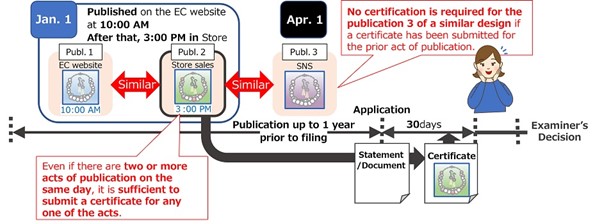Recent Revisions to Design Law
22 Mar 2024 | Newsletter

The 2023-revised Design Law, which was promulgated on 14 June 2023, relaxed the procedures to apply the exception to lack of novelty when filing a design application. For a design application filed on or after 1 January 2024, even when the design applicant published designs identical or similar to the claimed design multiple times prior to the filing date, the applicant has only to submit a certificate for the first disclosure of the identical or similar design. This revision is expected to considerably reduce the burden of design applicants.
Introduction
The Japanese government has taken various measures over the past several years to strengthen the design system and improve the usability. Most prominent examples were the 2019 revisions to the Design Law, which included expansion of the scope of designs eligible for design right protection to newly include designs for Graphical User Interface (GUI), building and interior, enhancement of the related design system by relaxing the requirements for filing related design applications, and change in the duration of design rights to 25 years from the filing dates. And the most recent measure introduced by the 2023-revised law: relaxed procedures for seeking the application of exceptions to lack of novelty of design.
Backgrounds
In principle, a design that has been published prior to the filing of a design application or a design similar thereto is no longer eligible for a design registration (Article 3, paragraph 1 of the Design Law). However, as an exception, a design that has been published as a result of an act of a person entitled to obtain a design registration or his/her assignee is treated as not having lost its novelty by the publication, provided that a design application is filed within one year from the date of its first publication, a request to apply for the exception to lack of novelty is submitted at the time of filing, and a certificate for the publication is submitted within 30 days from the filing date (Article 4, paragraphs 2 and 3 of the Design Law). This procedure allows for a design that has already been published to be still eligible for a design registration.
Prior to the revision, if a design identical or similar to a design claimed in a design application was published two or more times prior to the filing date, it was necessary to submit a certificate for each and every one of such acts of publication in principle.
However, it has become a heavy burden for a design applicant to prove all such acts of publication exhaustively, as the number of opportunities for publication of designs has increased in recent years due to recent changes in business environments, such as sales on e-commerce sites, increased advertising activities through SNS, etc. This revision aims to reduce the burden of such procedures for design applicants.
Procedures under the Revised Law
According to the 2023-revised Design Law, for a design application filed on or after 1 January 2024, when the design applicant applies for the exception to lack of novelty by submitting a certificate for a design published before the filing date, the effect of the exception to lack of novelty applies not only to the published design shown in the certificate, but also to any identical or similar designs subsequently published by the applicant. In other words, even when the design applicant published designs identical or similar to the claimed design multiple times prior to the filing date, the applicant has only to submit a certificate for the first disclosure of the identical or similar design.
Therefore, in the example shown in the picture below, where the designs of Publication 1, Publication 2, and Publication 3 are similar to each other, if the design applicant submits a certificate for either Publication 1 or Publication 2, which has the earliest publication date, then the exception to lack of novelty applies to all of Publication 1, Publication 2, and Publication 3.
See picture at the top – Cited from the JPO website: https://www.jpo.go.jp/e/system/laws/rule/other/design/ishou-reigai-tetsuduki.html
Some points to note
- A separate certificate is required for any published design that is dissimilar to the design shown in the submitted certificate. In the above example, if the design of Publication 3 is not similar to the design of Publication 1 or 2, then it is not possible to omit a certificate for Publication 3 in order to apply for the exception of lack of novelty for the design of Publication 3.
- Pursuant to Article 60-7(2) of the 2021-revised Design Law, an applicant of an international application designating Japan under the “Geneva Act of the Hague Agreement concerning the International Registration of Industrial Designs” may submit a certificate proving that the design meets the requirements for the exception to lack of novelty with ANNEX II at the time of filing of the international application. Alternatively, pursuant to Article 60-7(1) of the Design Law, it is also possible to submit a certificate proving that the design meets the requirements for the exception to lack of novelty within 30 days from the international publication via a Japanese agent.
- Even if the exception to lack of novelty is applied, the filing date of the design application is not retroactive. In addition, a design that has been published by a third party (i.e., neither a person entitled to obtain a design registration or his/her assignee) is not eligible for the exception to lack of novelty. Therefore, it is still recommended to file a design application as soon as possible, hopefully before any publication of identical or similar designs without relying on the exception to lack of novelty.
Relevant links:
“Procedures for Seeking the Application of Exceptions to Lack of Novelty of Design, corresponding to the Design Act Article 4,” JPO website: https://www.jpo.go.jp/e/system/laws/rule/other/design/ishou-reigai-tetsuduki.html
“Your Key to Success for Obtaining a Design Right in Japan,” JPO website: https://www.jpo.go.jp/resources/report/sonota-info/document/panhu/design_right_injapan.pdf
